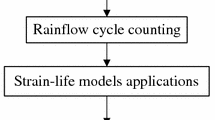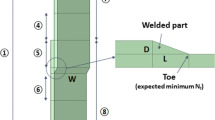Abstract
In this paper, a novel combined fatigue life reliability analysis model is constructed from the perspective of inverse analysis of Manson-Coffin equation. By the derived equivalent threshold of low cycle fatigue life, the failure event that the combined fatigue life is less than or equal to the presupposed threshold is equivalently transformed into the event that the actual strain range in the low cycle fatigue mode is larger than or equal to the inverse strain range threshold. The inverse strain range threshold corresponds to the equivalent threshold of low cycle fatigue life derived by the presupposed threshold of combined fatigue life. Then, the inverse strain range-based limit state function is constructed to analyze the fatigue life reliability, where solution of the exponential Manson-Coffin equation which is used to determine the low cycle fatigue life is avoided. A combination of the inverse strain range-based limit state function and adaptive Kriging (AK) model is constructed first to estimate the combined fatigue life reliability where the AK model directly surrogates the inverse strain range-based limit state function, and this algorithm is defined as a full-surrogate algorithm. The inverse strain range-based limit state function consists of two nested parts. The first part is the structural analysis which is usually an implicit function and the second part is the life analysis which is usually an explicit function. In this regard, another combination of the inverse strain range-based limit state function and AK model is constructed to estimate the combined fatigue life reliability, where the AK model only surrogates a part of inverse strain range-based limit state function, i.e., the implicit structural analysis part, and this algorithm is regarded as a semi-surrogate algorithm. Two aero-engine structures are analyzed to validate the effectiveness of the proposed method.








Similar content being viewed by others
References
Amaro RL, Antolowich SD, Neu RW, Fernandez-Zelaia P, Hardin WG (2012) Thermomechanical fatigue and bithermal-thermomechanical fatigue of a nickel-base single crystal superalloy. Int J Fatigue 42:165–171
Au SK, Beck JL (2001) Estimation of small failure probabilities in high dimensions by subset simulation. Probabilistic Eng Mech 16(4):263–277
China aeronautical materials handbook (n.d.) The second edition
Echard B, Gayton N, Lemaire M (2011) AK-MCS: an active learning reliability method combining Kriging and Monte Carlo simulation. Struct Saf 33:145–154
Grooteman F (2008) Adaptive radial-based importance sampling method for structural reliability. Struct Saf 30:533–542
Han GM, Yu JJ, Sun XF, Hu ZQ (2011) Thermo-mechanical fatigue behavior of single crystal nickel-based superalloy. Mater Sci Eng A 528(19/20):6217–6224
Hao P, Feng SJ, Li YW, Wang B, Chen HH (2020) Adaptive infill sampling criterion for multi-fidelity gradient-enhanced Kriging model. Struct Multidiscip Optim 62:353–373
Holmstörm S, Auerkari P (2013) A robust model for creep-fatigue life assessment. Mater Sci Eng A 559:333–335
Kersaudy P, Sudret B, Varsier N, Picon O, Wiart J (2015) A new surrogate modeling technique combining Kriging and polynomial chaos expansions. Application to uncertainty analysis in computational dosimetry. J Comput Phys 286:103–117
Lanning D, Haritos GK, Nicholas T (2001) Low-cycle fatigue/high cycle fatigue interaction in notched Ti-6Al-4V. Fatigue Fract Eng Mater Struct 24(9):565–578
Larson FR, Miller J (1952) A time-temperature relationship for rupture and creep stress. Trans ASME 74:765
Lee KO, Hong SG, Lee SB (2008) A new energy-based fatigue damage parameter in life prediction of high-temperature structural materials. Mater Sci Eng A 496(1-2):471–477
Liu JS (2001) Monte Carlo strategies in scientific computing. Springer, New York
Manson SS (1965) Fatigue: a complex subject-some simple approximation. Exp Mech 5(4):193–226
Manson SS, Halford GR (1981) Practical implementation of the double liner damage rule and damage curve approach for treating cumulative fatigue damage. Int J Fract 71(2):169–192
Martinez-Frutos J, Herrero-Perez D (2016) Kriging-based infill sampling criterion for constraint handling in multi-objective optimization. J Glob Optim 64:97–115
Miner MA (1945) Cumulative damage in fatigue. J Appl Mech 12(3):159–164
Morrow JD (1965) Cyclic plastic strain energy and fatigue of metals. Internal Friction & Damping & Cyclic Plasticity 378:45–86
Oakley SY, Nowell D (2007) Prediction of the combined high-and low-cycle fatigue performance of gas turbines after foreign object damage. Int J Fatigue 29(1):69–80
Papaioannou I, Breitung K, Straub D (2018) Reliability sensitivity estimation with sequential importance sampling. Struct Saf 75:24–34
Ritchie RO, Boyce BL, Campbell JP, Order O, Thompson AW, Milligan WW (1999) Thresholds for high-cycle fatigue in a turbine engine Ti-6Al-4V alloy. Int J Fatigue 21:653–662
Sacks J, Schiller SB, Welch WJ (1989) Design for computer experiment. Technometrics 31(1):41–47
Toland J, Goswami T (2004) General creep-fatigue life prediction models. J Mech Behav Mater 15(1-2):93–106
Trufyakov VI, Kovalchuk VS (1982) Determination of life under two-frequency loading: report 2: proposed method. Strength of Materials 10:15–20
Wang ZY, Shafieezedeh A (2019) ESC: an efficient error-based stopping criterion for Kriging-based reliability analysis methods. Struct Multidiscip Optim 59:1621–1637
Wang ZQ, Wang PF (2015) A double-loop adaptive sampling approach for sensitivity-free dynamic reliability analysis. Reliab Eng Syst Saf 142:346–356
Xiao M, Zhang JH, Gao L, Lee S, Eshghi AT (2019) An efficient Kriging-based subset simulation method for hybrid reliability analysis under random and interval variables with small failure probability. Struct Multidiscip Optim 59:2077–2092
Xiao NC, Zhan HY, Yuan K (2020) A new reliability method for small failure probability problems by combining the adaptive importance sampling and surrogate models. Comput Methods Appl Mech Eng 372:113336
Yun WY, Lu ZZ, Jiang X (2018) An efficient reliability analysis method combining adaptive Kriging and modified importance sampling for small failure probability. Struct Multidiscip Optim 58:1383–1393
Yun WY, Lu ZZ, Jiang X, Zhang LG, He PF (2020) AK-ARBIS: an improved AK-MCS based on the adaptive radial-based importance sampling for small failure probability. Struct Saf 82:101891
Zhang JH, Xiao M, Gao L, Chu S (2019) A combined projection-outline-based active learning Kriging and adaptive importance sampling method for hybrid reliability analysis with small failure probabilities. Comput Methods Appl Mech Eng 344:13–33
Funding
This work was supported by the Natural Science Foundation of China (Grant No. 12002237), the Project funded by China Postdoctoral Science Foundation (No. 2019M661610), and the National Science and Technology Major Project (Grant No. 2017-IV-0009-0046).
Author information
Authors and Affiliations
Corresponding author
Ethics declarations
Conflict of interest
The authors declare that they have no conflict of interest.
Replication of results
The original codes of the examples in Section 4 are available in the Supplementary materials.
Additional information
Responsible Editor: Byeng D Youn
Publisher's note
Springer Nature remains neutral with regard to jurisdictional claims in published maps and institutional affiliations.
Supplementary Information
ESM 1
(ZIP 1.44 kb)
Appendix
Appendix
1.1 The basic theory of the Kriging model
The Kriging model includes two parts. The first part is the parametric linear regression part and the second part is the nonparametric stochastic process part. The Kriging model of an unknown function g(X) is described as follows (Sacks et al. 1989; Kersaudy et al. 2015).
where B(X) = [B1(X), B2(X), …, Bp(X)]T are the base functions of vector X, β = [β1, β2, …, βp]T is the regression coefficient vector, and p is the number of base function. S(X) is a stationary Gaussian process with zero mean and covariance which is defined as follows:
where NT denotes the number of training points.
Define \( \boldsymbol{R}=\left[\begin{array}{ccc}R\left({\boldsymbol{x}}_1,{\boldsymbol{x}}_1\right)& \cdots & R\left({\boldsymbol{x}}_1,{\boldsymbol{x}}_{N_T}\right)\\ {}\vdots & \ddots & \vdots \\ {}R\left({\boldsymbol{x}}_{N_T},{\boldsymbol{x}}_1\right)& \cdots & R\left({\boldsymbol{x}}_{N_T},{\boldsymbol{x}}_{N_T}\right)\end{array}\right] \), \( \boldsymbol{B}=\left[B{\left({\boldsymbol{x}}_1\right)}^T,B{\left({\boldsymbol{x}}_2\right)}^T,\dots, B{\left({\boldsymbol{x}}_{N_T}\right)}^T\right] \) and g is the corresponding vector of the function g(X) calculated at each experiment points xi(i = 1, 2, …, NT), the unknown β and σ2 can be estimated by the following equations, i.e.,
Therefore, the Kriging mean and Kriging variance are given as follows:
where \( {\boldsymbol{r}}^T\left(\boldsymbol{X}\right)={\left[R\left(\boldsymbol{X},{\boldsymbol{x}}_1\right),\dots, R\left(\boldsymbol{X},{\boldsymbol{x}}_{N_T}\right)\right]}^T \).
Rights and permissions
About this article
Cite this article
Yun, W., Lu, Z., Zhang, W. et al. A novel inverse strain range-based adaptive Kriging method for analyzing the combined fatigue life reliability. Struct Multidisc Optim 64, 3311–3330 (2021). https://doi.org/10.1007/s00158-021-02966-4
Received:
Revised:
Accepted:
Published:
Issue Date:
DOI: https://doi.org/10.1007/s00158-021-02966-4




